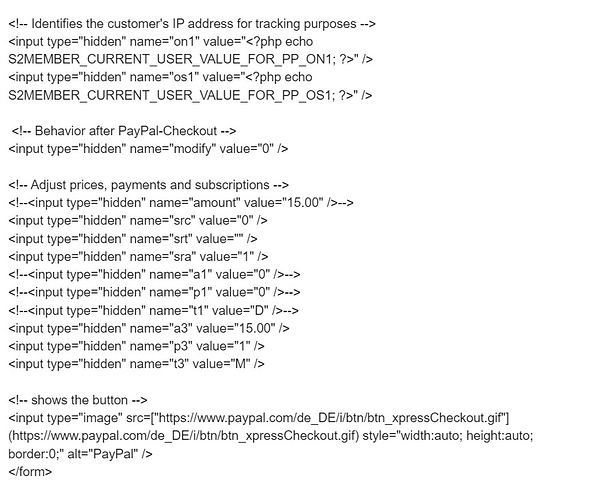Hi there,
I am using S2member for a very long time. Have a little wordpress blog, where clients have to pay for articles and publications and then they get access for a period of time. Set it up for simple Paypal payments (not Paypal Pro / Payflow). And as additional info, my Paypal button is transmitted in encrypted form (encrypted by S2member).
May be I have also to say that I am from Germany.
All worked fine for years until this monday.
My Paypal button didn’t worked anymore - error page from Paypal. Contacted the support, they said may be it is the authentification and that my button is outdated. They recommend to build a new button with the tools on their webpage (Jesus, that’s a mess).
Anyway, I managed to create a new button and add it to my site again. And indeed, the payment process is initiated and money even ends up in my merchant account.
The problem is the correct feedback to S2member. In the current process, I have not yet managed to integrate the S2member member variables of my customers into the new button code. So in the end S2member doesn’t know who actually bought what.
That here was my old short code:
[s2Member-PayPal-Button level=“1” ccaps="" desc=“my article-description” ps=“paypal” lc="" cc=“EUR” dg=“0” ns=“1” custom=“mywebsite” ta=“0” tp=“0” tt=“D” ra=“15.00” rp=“1” rt=“M” rr=“BN” rrt="" rra=“1” image=“default” output=“button” /]
The old shortcode produced this form element: (line breaks for better reading)
Now I did following, I went to my merchant account and set up a simple Checkout Button. Paypal generates this code:
In Paypal’s code generator I can enter my article description, the price, the kind of shippment and so on. I have also an extra field, where I can put some variables into the code.
Eligible variables are listed here:
developer.paypal.com/api/nvp-soap/paypal-payments-standard/integration-guide/Appx-websitestandard-htmlvariables/
In the end, Paypal render all together under this hosted Button ID, and give you that form element for your website.
I tried different ways to get in these S2member PHP variables, but without success.
Is that even possible? For example I tried to enter this in the extra field for variables:
invoice=<?php echo S2MEMBER_VALUE_FOR_PP_INV(); ?>
os1=<?php echo S2MEMBER_CURRENT_USER_VALUE_FOR_PP_OS1; ?>
os0=<?php echo S2MEMBER_CURRENT_USER_VALUE_FOR_PP_OS0; ?>
on0=<?php echo S2MEMBER_CURRENT_USER_VALUE_FOR_PP_ON0; ?>
and so on, but it didn’t worked. At this point my knowledge and my skills as developer are not good enough (I’ am a publisher not a coder). So, may be anybody is out where, who can give me a tip, how I can fix that problem.
Thank you very much.
Robert






 ).
).